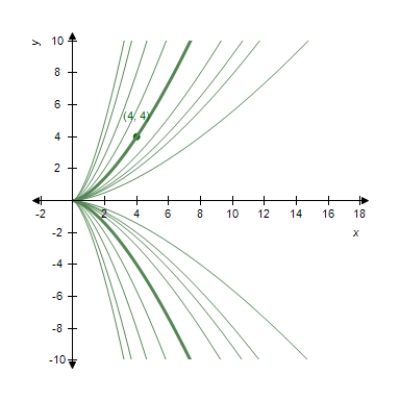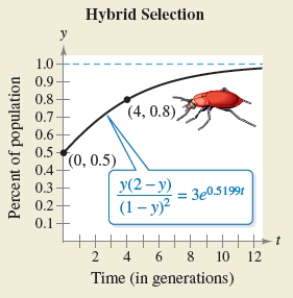A) ![]()
B) ![]()
C) ![]()
D) ![]()
E) ![]()
Correct Answer

verified
Correct Answer
verified
Multiple Choice
Some of the curves corresponding to different values of C in general solution of the differential equation  ,
,  are shown in the figure given below.Find the particular solution that passes through the points plotted on the graph.
are shown in the figure given below.Find the particular solution that passes through the points plotted on the graph.

A) ![]()
B) ![]()
C) ![]()
D) ![]()
E) ![]()
Correct Answer

verified
Correct Answer
verified
Multiple Choice
Write the first-order linear differential equation in standard form. 
A) ![]()
B) ![]()
C) ![]()
D) ![]()
E) ![]()
Correct Answer

verified
Correct Answer
verified
Multiple Choice
Determine whether  is a solution of the differential equation
is a solution of the differential equation 
A) ![]() and
and ![]()
B) ![]() and
and ![]()
C) ![]() and
and ![]()
D) ![]() and
and ![]()
E) ![]() and
and ![]()
Correct Answer

verified
Correct Answer
verified
Multiple Choice
Use the initial condition to find the particular solution of the differential equation.  ,
,  when
when 
A) ![]()
B) ![]()
C) ![]()
D) ![]()
E) ![]()
Correct Answer

verified
Correct Answer
verified
Multiple Choice
Write the the differential equation by separating the variables. 
A) ![]()
B) ![]()
C) ![]()
D) ![]()
E) ![]()
Correct Answer

verified
Correct Answer
verified
Multiple Choice
Find the particular solution that satisfies the initial condition.  ; Initial Condition:
; Initial Condition:  when
when 
A) ![]()
B) ![]()
C) ![]()
D) ![]()
E) ![]()
Correct Answer

verified
Correct Answer
verified
Multiple Choice
Use the hybrid selection model described to find the percent y (in decimal form) of the population that has the indicated characteristics as a function of time t (in generations) .  when
when  ;
;  when
when 

A) ![]()
B) ![]()
C) ![]()
D) ![]()
E) ![]()
Correct Answer

verified
Correct Answer
verified
Multiple Choice
Write the the differential equation by separating the variables. 
A) ![]()
B) ![]()
C) ![]()
D) ![]()
E) ![]()
Correct Answer

verified
Correct Answer
verified
Multiple Choice
The isotope  has a half-life of 1,599 years.Given an initial amount of 13 grams of the isotope,how many grams will remain after 1,500 years? After 15,000 years? Round your answers to four decimal places.
has a half-life of 1,599 years.Given an initial amount of 13 grams of the isotope,how many grams will remain after 1,500 years? After 15,000 years? Round your answers to four decimal places.
A) 4.7495 g, 0.0137 g
B) 2.714 g, 0.0078 g
C) 6.785 g, 0.0195 g
D) 8.142 g, 0.0234 g
E) 4.071 g,0.0273 g
Correct Answer

verified
Correct Answer
verified
Multiple Choice
Assume that the rate of change in y is proportional to y.Solve the resulting differential equation  and find the particular solution that passes through the points
and find the particular solution that passes through the points  ,
, 
A) ![]()
B) ![]()
C) ![]()
D) ![]()
E) ![]()
Correct Answer

verified
Correct Answer
verified
Multiple Choice
Use this equation  and find A for each situation.
(a)
and find A for each situation.
(a)  ,
,  and
and  years
(b)
years
(b)  ,
,  and
and  years
years
A) a) 685,099.00
b) 5,802,815.12
B) a) 585,099.00
b) 5,802,815.12
C) a) 685,099.00
b) 6,802,815.12
D) a) 585,099.00
b) 4,802,815.12
E)
a) 485,099.00
b) 5,802,815.12
Correct Answer

verified
Correct Answer
verified
Multiple Choice
Solve for y in two ways.

A) ![]()
B) ![]()
C) ![]()
D) ![]()
E) ![]()
Correct Answer

verified
Correct Answer
verified
Multiple Choice
Find the general solution of the first-order linear differential equation.

A) ![]()
B) ![]()
C) ![]()
D) ![]()
E) ![]()
Correct Answer

verified
Correct Answer
verified
Multiple Choice
Use separation of variables to find the general solution of the differential equation. 
A) ![]()
B) ![]()
C) ![]()
D) ![]()
E) ![]()
Correct Answer

verified
Correct Answer
verified
Multiple Choice
Find the general solution of the first-order linear differential equation.

A) ![]()
B) ![]()
C) ![]()
D) ![]()
E) ![]()
Correct Answer

verified
Correct Answer
verified
Multiple Choice
Find the general solution of the first-order linear differential equation.

A) ![]()
B) ![]()
C) ![]()
D) ![]()
E) ![]()
Correct Answer

verified
Correct Answer
verified
Multiple Choice
Determine whether  is a solution of the differential equation
is a solution of the differential equation 
A) ![]()
B) ![]()
C) ![]()
D) ![]()
E) ![]()
Correct Answer

verified
Correct Answer
verified
Multiple Choice
Use separation of variables to find the general solution of the differential equation. 
A) ![]()
B) ![]()
C) ![]()
D) ![]()
E) ![]()
Correct Answer

verified
Correct Answer
verified
Multiple Choice
Determine whether the function  is a solution of the differential equation
is a solution of the differential equation 
A) Not a solution
B) Solution
Correct Answer

verified
Correct Answer
verified
Showing 41 - 60 of 77
Related Exams